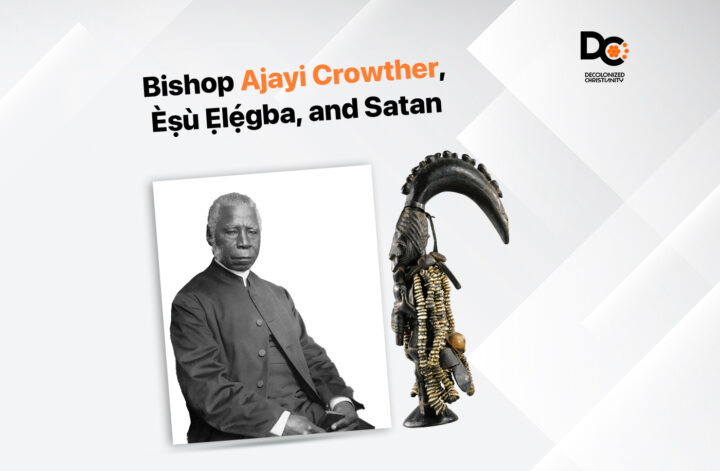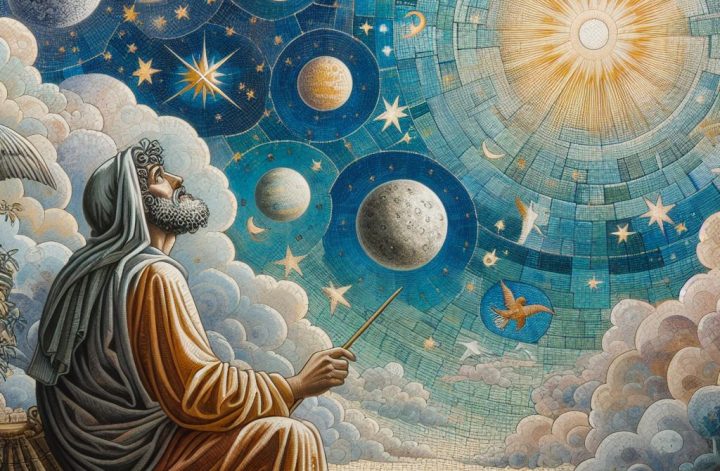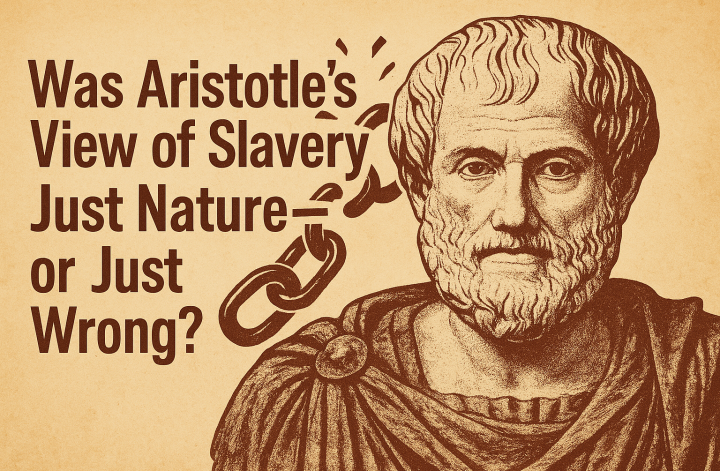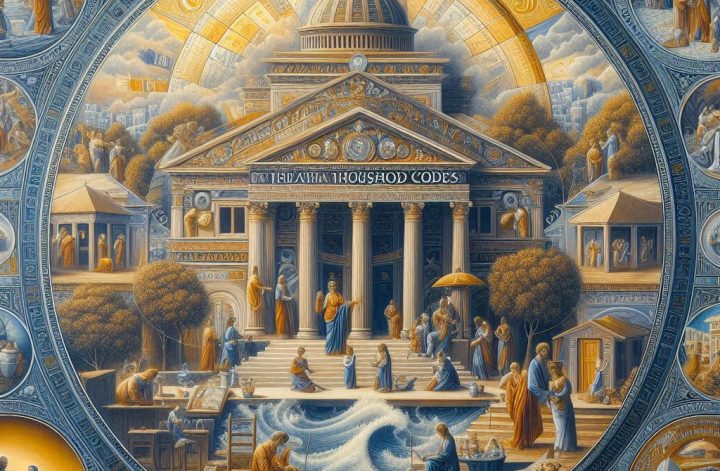We have told the story of Bishop Ajayi’s early life. The teenage Ajayi was captured by his compatriots and sold into slavery. But for the interception of a British squadron, Ajayi would have been sold in the trans-Atlantic slave trade and might never have been known—just like the innumerable millions who perished in that grand evil scheme. It is hard to imagine that Ajayi, especially as he would later have learned about what could have been, would not have felt like he owed his life to Britain. Not only was he saved by British sailors, but he was also educated and introduced to Christianity by British missionaries. Considering the history of Britain at the time, we may assume that racist and hegemonic inclinations tainted the Christian education he received. So, it should not be shocking if we find vestiges of Eurocentrism in Crowther’s works. What should be more critical is what Crowther willfully believed and defended.
Critics have pointed out how Crowther selectively translated “devil” as “Èṣù.” This observation is the most potent critique against Crowther’s translation work. Not only did Crowther retain “Satan” (adapted to “Satani”) in the Old Testament when, as already argued, the notion of God’s arch-enemy was not fully developed, but he also retained “Satan” in the New Testament. Without a justification for this choice, it strongly suggests that Crowther equated “devil” with “Esu.” However, it does not follow that Crowther also equated or confused the devil for Èṣù. A cursory look at the manner of use of “Èṣù” in Crowther’s work would have immediately made it clear that his “Èṣù” was different. Consider the following passages:
Therefore rejoice, O heavens, and you who dwell in them! Woe to the inhabitants of the earth and the sea! For the devil has come down to you, having great wrath, because he knows that he has a short time.”—Revelation 12:12
Crowther translated “the devil” of this passage as “Esu.” Contextually, this passage implies that Èṣù used to reside in Ọ̀run and was displaced to live on Aiyé. But the Yoruba metanarrative says nothing about the pantheon rejoicing because of Èṣù’s displacement to the earth. On the contrary, Èṣù remains the god of crossroads who is not necessarily against humans. Hence, Crowther’s “Esu” does not refer to the Yoruba deity. Below is another passage:
And he cried mightily with a strong voice, saying, Babylon the great is fallen, is fallen, and is become the habitation of devils, and the hold of every foul spirit, and a cage of every unclean and hateful bird. —Revelation 18:2
Once again, Crowther translated “devils” here as “àwọn ẹ̀mí Èṣù” (literally, “spirits of Esu”). This is a classic case of a foreign idea expressed in the Yoruba language with attending awkwardness. Yoruba metaphysics knows nothing about the “spirits of Èṣù.” On the contrary, Yorùbá only recognizes Èṣù as one of many deities. Perhaps, the most instructive case is how Crowther renders James 4:7,
Submit yourselves therefore to God. Resist the devil, and he will flee from you.
Interestingly, Crowther renders “resist the devil” as “Ẹ kọ ojú ìjà sí Èṣù” (meaning, “fight/war against Èṣù”). But Yoruba traditional Èṣù is not a deity to fight. Indeed, he is practically the only hope of humanity! No Yoruba contemporary of Crowther would have failed to notice the difference between Crowther’s Èṣù and the traditional god.
Besides the charge of Crowther’s consistent translation of “devil” as “Esu,” critics often cite lines from Crowther’s letters and journals to argue for his disdain for Yoruba metaphysics. In an oft-cited passage from Crowther’s journals, we read:
. . . about the third year of my liberation from slavery of man, I was convinced of another worse state of slavery, namely that of sin and Satan. It pleased the Lord to open my heart. . . I was admitted into the visible church of Christ here on earth as a soldier to fight manfully under his banner against our spiritual enemies. (Quoted in Adefarakan, 44).
Here, we see how Crowther coped with the mind-torturing slavery he experienced. He considered it less than the slavery of “sin and Satan.” This language likely merely reflects the teaching Crowther received about Christian salvation. Some critics, however, see in the passage a demonization of Yoruba land and metaphysics. Temitope Adefarakan, for instance, writes (44):
What the above passage reveals is Crowther’s ontological and epistemological shift from a young man who was comfortably immersed in a Yoruba worldsense, to one who equated that very worldsense with slavery, sin and Satan and, in fact, indexing it as worse than human slavery, a type of spiritual slavery, if you will.”
(“Worldsense” is Adefarakan’s preferred African equivalent of “worldview” as she does not believe that African metaphysics privileges the visual sense over others.) Adefarakan sees Crowther here equating the Yoruba understanding of the world with spiritual slavery, sin, and Satan. She supports her conclusion with another quotation from a letter Crowther wrote in 1837 to the then CMS Secretary, Reverend William Jowett (44-45):
I suppose sometimes about the commencement of the year 1821, I was in my Native country, enjoying the comforts of father and mother, and the affectionate love of brothers and sisters. From this period I must date the unhappy, but which I am now taught, in other respects, to call blessed day, which I shall never forget in my life. I call it unhappy day, because it was the day in which I was violently turned out of my father s house, and separated from relations; and in which I [was] made to experience what is called to be in slavery—with regard to it being called blessed, it being the day which Providence had marked out for me to set out on my journey from the land of heathenism, superstition, and vice, to a place where His Gospel is preached.
Adefarakan stresses how Crowther here describes Yorubaland as “the land of heathenism, superstition, and vice”. But, as even Adefarakan observes, this merely reflected “what Crowther was taught to believe while in the care of the Christian Missionary Society in Sierra Leone” (45). But then she adds, “Crowther has uncritically embraced and internalized the Euro-Christian worldview at the expense of his Indigenous Yoruba worldsense” (45). This latter statement, however, is a mere assertion.
Adefarakan has not shown that Crowther “uncritically embraced and internalized the Euro-Christian worldview.” There is a more straightforward way to explain Crowther’s statement. Then a Christian, Crowther could think back about his ancestral land as one of “heathenism” because, well, the people did not believe as he did in Yahweh, and nobody preached the Gospel in Yorubaland. While Crowther could have used “heathenism” with the derogatory undertone characteristic of British usage of the term, and as Adefarakan argues, there is evidence of Crowther using the word positively. In an 1869 address to African missionaries in Lokoja, Stephen Ney (44) writes of Crowther saying, “If any activity ‘is not immoral or indecent, tending to corrupt the minds but merely an innocent play for amusement, it should not be checked because of its being native and of a heathen origin’” (emphasis added). As to the description of the land as one of vice, Crowther can hardly be faulted. We can scarcely describe the land and people who sold him into slavery as virtuous.
Besides, there is evidence that Crowther critically assessed the Euro-Christian worldview he received. In the early days of the missions to the Niger, Europeans had more favorable, even if racist, views of Africans. Henry Venn, the CMS Secretary in 1851, for example, wanted “to strengthen the indigenous ministry” by seeking to make “self-governing, self-supporting, self-propagating churches with a fully indigenous pastorate” (Walls, 19). Henry Venn believed that African churches could self-govern themselves, and they did. But things changed in the latter days of Bishop Crowther. Andrew Walls writes (19),
European thought about Africa had changed since the time of Buxton; the Western powers were now in Africa to govern. Missionary thought about Africa had changed since the days of Henry Venn; there were plenty of keen, young Englishmen to extend the mission and order the church; a self-governing church now seemed to matter much less.
This development happened after the Whiteness-infected Scramble for Africa at the Berlin Conference of 1884. It became fashionable in Europe to assert that Africans could not govern themselves and needed Europeans to govern them. European missionaries did take over the mission, “brushing aside the old bishop (he was over eighty) and suspending or dismissing his staff” (Walls, 19). In 1891, Crowther died of a stroke.
A European bishop replaced Crowther, despite the availability of several capable indigenous candidates. This racist development and many others would eventually lead to the formation of African independent churches (Walls, 20). A key attribute of African independent churches (AICs) is their insistence on merging the African way of life with Christianity. For example, the AICs rejected European enforcement of monogamy in favor of traditional African polygamy. Contrary to what critics like Adefarakan would have us believe, how is a church development in protest of the European treatment of Bishop Crowther so proudly African in its outlook if the bishop “uncritically embraced and internalized the Euro-Christian worldview”? Indeed, Ney’s quote is worth repeating in its broader context. He writes concerning Crowther, “Christianity, he says, does not reject African collective identities. If any activity “is not immoral or indecent, tending to corrupt the minds but merely an innocent play for amusement, it should not be checked because of its being native and of a heathen origin” (44). Crowther encouraged engaging Christianity with “Africanness.”
Another line of reasoning often marshaled against Bishop Crowther claims that he was an angry fellow who sought to avenge his maltreatment. In a quite enjoyable written speech, Funso Aiyejina writes (4-5),
The irony of the choices made by the Crowthers of the African world is that in their psychological disdain for, and rejection of, African culture, which was, in part, a response to the African involvement in their enslavement, they became a new generation of middle-men and -women who functioned as arrowheads for the denigration of African cultures. So, while a number of pre-colonial African chiefs and merchants betrayed their fellow Africans by selling them into enslavement, the intellectual Crowthers, acting as priests, interpreters, translators, policemen, postmasters, and school teachers, were key players in the process of the religious, psychological and mental enslavement of African peoples.
In Aiyejina’s conception, Bishop Crowther is the stellar example of Africans who willfully became veritable colonial tools and played crucial roles in the religious enslavement of Africans. Aiyejina (5) elaborates on this “religious enslavement” when he writes in a paragraph worth quoting at length,
If Africans had been less trusting and more cynical and suspicious, they would have wondered why the same translators of the Bible who saw nothing wrong with equating Satan with Esu did not find a near-equivalent Yoruba deity for Jesus Christ, instead of Yorubanising his name into Jesu Kristi. If Satan translates into Esu because of some perceived incidental similarities between the two, how come Jesus does not translate into Orunmila, given the fact that Orunmila is as proverbial, wise, calm, peaceful, and forbearing as Jesus? How come he does not translate to Ela, the divinity of regeneration? Of course, such a logical approach would have undermined the policy of discrediting African world-views and would have suggested a cultural equity between the West and Africa that Europe was not minded to concede. It would not be until much later in the interaction between Africa and Europe in the Americas that a democratic principle of equity between Christianity and the Orisa tradition would be initiated by Spiritual Baptists, who would erect a structure that would equate the Orisa with Christian saints, with Esu being equated to St. Peter in recognition of their gate-keeping and intercessory roles.
Aiyejina uses “religious enslavement” to refer to the process that claims that African traditional religions are inferior. In his view, Crowther’s choice of rendering Satan as Èṣù is a move that demonizes Yoruba metaphysics. Expressing a similar thought, Adefarakan writes that Crowther specifically targeted Esu, of all the orisa in the pantheon, “because of Esu’s unique role and function within the Yoruba metaphysical system” (emphasis in the original, 39).
These critiques are off-target. First, it is unclear what Aiyejina means by “psychological disdain for, and rejection of, African culture.” Does he mean to include any African who rejects a portion of the culture but embraces the rest? Indeed, what is “African culture,” and is it immutable? One must imagine that Aiyejina would answer these questions in the negative. To do otherwise would include himself, “a professor of literatures in English,” in the mix. But if he answers negatively, why should someone who privileges “Euro-Christianity” over its traditional counterpart be any less African? The idea that Africans who embrace foreign religions are somewhat less African is deceptive, especially when we consider that many, such as Wole Soyinka, who claim to embrace African traditional religions, deny the realism of the gods.
Aiyejina’s assertion that Crowther was an angry man seeking revenge is also not persuasive. Of course, it would be completely understandable if Crowther remained infuriated for being sold into slavery. But translating “Satan” as “Esu”—or more correctly, “devil” as “Èṣù”—is not an effective way to exact revenge. Indeed, with his knowledge of the Bible, a more effective way to exact revenge—an eternal one, at that—would be to borrow a leaf from the prophet Jonah, who chose to die over preaching to a people he intensely despised. Crowther could have refused to do missions in Yorubaland so that every Yoruba person may eternally perish, as Crowther’s Christian conception teaches.
Furthermore, Aiyejina’s rhetorical questions on why Crowther only used “Esu,” of all the pantheon members, in his translation work is also misguided. Specifically, the reasoning here is guilty of assuming that Crowther intended his “Èṣù” to pick out the same referent as the traditional Yoruba “Esu.” It is pretty alarming how scholarship on the matter missed this point. Aiyejina’s questions are meaningful only if Crowther meant to assert a one-to-one correspondence between the referents of the terms—and critics are yet to establish that. Indeed, it is implausible that Crowther would have meant a one-to-one correspondence. Crowther’s work is a translation of a work conveying a different metanarrative. He could not have arbitrarily changed the attributes of Satan to those of Èṣù Ẹlẹ́gba.
Moreover, the assumption that Crowther corrupted Yoruba metaphysics through his translation work is guilty of severely belittling Crowther’s contemporary Ifa priests and adherents. Even if Crowther were so angry that he believed Satan and Ẹlẹ́gbara to be the same person, Ifa priests would have begged to differ. They would have pointed out to Crowther that his Èṣù (and Ọlọ́run, in fact) are only superficially like traditional Yoruba divinities by those names. More importantly, the Ifa priests would have ended such a conversation with exactly zero change to their beliefs. Hence, Crowther would not have corrupted anything.
Besides, we know that Crowther was not such an irrational being. In his encounters with Islam, a religion that claims historical reliance on the Bible and adherents of which Crowther could be justified to hate since Oyo Muslims sold him into slavery, Bishop Crowther “reflected the patience and the readiness to listen that marked his entire missionary method (Walls, 19). Though the Quran claims contrary to some cornerstone Christian beliefs, “Crowther sought common ground and found it at the nexus of Qur’an and Bible: Christ as the great prophet, his miraculous birth, Gabriel as the messenger of God (Walls, 19). Crowther befriended many Muslim rulers and clerics. In the final analysis, and regarding his apologetics works to Muslims, Crowther concluded: “After many years’ experience, I have found that the Bible, the sword of the Spirit, must fight its own battle, by the guidance of the Holy Spirit” (Walls, 19). This picture is not of a man taken over by anger or seeking revenge. Those who believe differently must prove their case.
Similarly, Adefarakan’s critiques are also misguided. Her claim that Crowther targeted the Yoruba traditional Èṣù for his central role and function in Yoruba metaphysics may be valid. But this does not amount to much. Crowther could have appropriated “Èṣù” to stimulate the minds of his readers—actually, primarily hearers—to consider the similarities and differences between the Christian Èṣù and Ẹlẹ́gbara and how the worldviews contrast. He could also have chosen “Èṣù” for its tonal similarity to “Jésù,” Crowther’s rendition of “Jesus.” This move would have made for easy mental connections (and conversations) in a primarily oral culture. However, if anyone confused the identities of Crowther’s and Yoruba traditional Èṣù figures, she would only need to attend a service at Ẹlẹ́gba’s temple to be reminded that the divine beings are different. In any case, Crowther may not be blamed for the confusion.
Adefarakan also writes (40):
The figure of the devil is central in Euro-Christian cosmology, hence an essential figure to the project of missionarism. The Bible is not the same without the devil, for he is needed as the quintessential antithesis to all that is good and all that is God. Esu is a central figure in the Yoruba cosmos, while Satan is a central figure in the Euro-Christian worldview.
The claim that “the devil is central in Euro-Christian cosmology” may be correct, but that is only because Adefarakan addresses “Euro-Christianity,” not Judeo-Christianity. The epic poems of Dante and John Milton enormously elevated Satan beyond Biblical bounds
Nevertheless, it is plausible that Crowther might have believed in an exaggerated view of Satan under the influence of a British education. However, that belief does not seem to feature in Crowther’s translation. If it does, it only amounts to an appropriation of a label, not confusion of identities, as already argued.
Surely, Bishop Crowther knew the Biblical story differed from the Yorùbá metanarrative. Yet, he must communicate his foreign myth in his native tongue. He might have appropriated “Èṣù” for its similarity to “Jésù.” In any case, a close reading of his translation work would reveal that Crowther’s Èṣù differs from the Yorùbá deity. Crowther’s critics have ignored the simple notion of a name and its referent that the philosophy of language has resolved. Slapping a label of “alcohol” on a bottle of water will not change the bottle’s content. Similarly, Crowther’s appropriation of “Èṣù” for “the devil” does not somehow confuse the respective deities.
Works Cited
Adefarakan, Temitope. “‘At a Crossroads’: Spirituality and The Politics of Exile: The Case of the Yoruba Orisa.” Obsidian, vol. 9, no. 1, 2008, pp. 31–58. JSTOR, http://www.jstor.org/stable/44489275. Accessed 21 Jun. 2022.
Aiyejina, Funso. “Esu Elegbara: A Source of an Alter/Native Theory of African Literature and Criticism.” St. Augustine, Trinidad and Tobago: The University of the West Indies, 2009. Internet resource.
Ney, Stephen. “Samuel Ajayi Crowther and the Age of Literature.” Research in African Literatures, vol. 46, no. 1, 2015, pp. 37–52. JSTOR, https://doi.org/10.2979/reseafrilite.46.1.37. Accessed 21 Jun. 2022.
Walls, Andrew F. “Samuel Ajayi Crowther (1807-1891) Foremost African Christian of the Nineteenth Century.” International Bulletin of Missionary Research, vol. 16, no. 1, 1992, 15–21. doi:10.1177/239693939201600104. Accessed May 25 2022.




